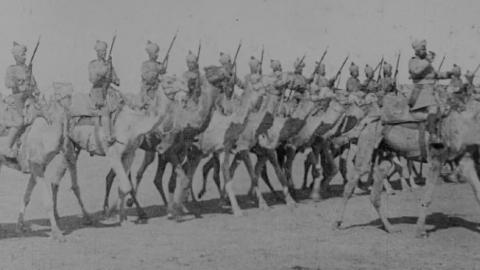This film is part of Free

Delhi Durbar
A film produced to celebrate the coronation of George V as King-Emperor at the Imperial Durbar of 1911.
Overview
Viceroy Lord Hardinge was instructed after the coronation of George V in June 1911 to organise an Indian equivalent to pageantries in Britain. The chosen model of an ‘Imperial Durbar’ was an old one. Previous shows of Indian obeisance before a representative of the Crown had occurred in 1877 and 1903 after Victoria and Edward VII were declared Empress and Emperor of India. The ceremonies organized by Hardinge at Delhi from 7th to 16th December 1911 operated within this invented tradition.
The Durbar was used to contrast British modernity with Indian tradition. Europeans at the Durbar were instructed to dress in contemporary styles even when celebrating an older British Imperial past (as with the ‘Mutiny’ veterans). Indians, however, were to wear Oriental costumes as motifs of their otherness. The construction of this exaggerated sense of Imperial order at the Durbar was significant. The event was used to declare New Delhi as the new capital of British India. Delhi was chosen as a refuge from the nationalist sentiment that had gripped the old capital of Calcutta. The Durbar was a show of Imperial continuity by an increasingly anxious Empire. Dr. Gajendra Singh (University of Exeter)
Related

Indian Procession Indian Procession
Non-Fiction 1902 3 mins Silent
Decorated elephants with howdahs, and troops on foot and horseback.

Delhi 1946 Delhi 1946
Amateur film 1946 15 mins Silent
8mm amateur film of India on the eve of Independence.

King George the Fifth's Durbar Held to Proclaim Him Emperor of India King George the Fifth's Durbar Held to Proclaim Him Emperor of India
Non-Fiction 1912 7 mins Silent
Patriotic dispatch from the grand celebrations to mark the start of George V's reign

Ruins of Delhi Ruins of Delhi
Interest film 1910 4 mins Silent
Attractive travelogue filmed in and around Delhi's Qutb complex.

Scenes of the Delhi Camp Scenes of the Delhi Camp
Non-Fiction 1911 3 mins Silent
A look at the 1911 Delhi Durbar - with a look back at its 1902 predecessor

Rajputana, Jhalawar, Bundi & Katakali Dancers Rajputana, Jhalawar, Bundi & Katakali Dancers
Amateur film 1940 11 mins Silent
A trip to the spectacular city of Bundi and a Kathakali dance performance, filmed in vivid colour by 'envoy of the Raj' Clarmont Skrine.

All We Imagine As Light - Exclusive Q&A All We Imagine As Light - Exclusive Q&A
Short interview 2025 28 mins
Payal Kapadia discusses her Cannes prize-winning and Bafta-nominated drama with Ashanti Omkar.

Khichdi Khichdi
Animation & Artists Moving Image 2023 16 mins
The interwoven stories of four best friends who reunite in the UK, thirty-five years after training together as nurses during their teens in Ferozepur, Punjab.

Dr XYZ: A Medical Drag Transthology Dr XYZ: A Medical Drag Transthology
Documentary 2023 15 mins
A satirical take on the healthcare service announcements of the 1960s and 70s.

Every Moment Counts Every Moment Counts
Animation & Artists Moving Image 2023 9 mins
A short animation that offers a window into the world of children’s palliative care.

Police Story: Panel Discussion Police Story: Panel Discussion
Inside Film 2024 24 mins
Panel discussion on Jackie Chan's 1985 action classic Police Story, with Chase Armitage, Sam Mak and Jadey Duffield.

China O'Brien: The Reunion China O'Brien: The Reunion
Documentary 2024 60 mins
Cynthia Rothrock, Richard Norton and Keith Cooke reunite three decades on from the groundbreaking martial arts classic.